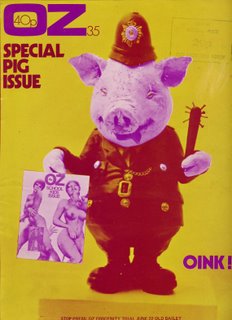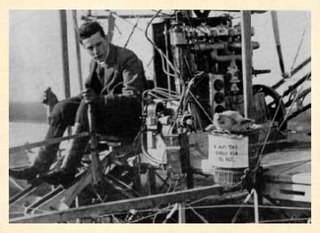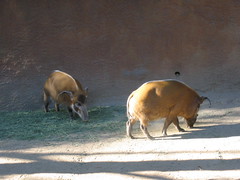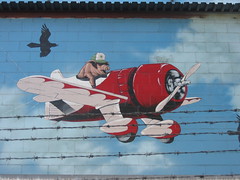Sunday, October 22, 2006
The Red River Hog (Potamochoerus porcus) is a wild member of the pig family that lives in Africa. These two actually live at the Los Angeles Zoo and were photographed while I was in Griffith Park this weekend.
When Pigs Fly 2 (Farmer John Murals)
After a trip to the Autry Western Heritage Center today for a panel on the Endangered Species Act and a visit to their Yosemite: Art of An American Icon exhibit, I swung by Vernon, California to take pictures of the Farmer John Murals. These depictions of happy pigs in an idyllic setting--I'll post more of them over time--grace the exterior of a meat packing company. The murals were begun in about 1957 by Les Grimes, a scenic artist who had worked for some of the film studios in Los Angeles. Grimes worked alone on the murals until November 14, 1968, when he fell to his death from scaffolding while working on an area of sky. The murals were finished and updated by Arno Jordan. You can find information about these murals on the official Farmer John site and in a lovely little book The Great Murals of Farmer John Brand, Clougherty Meat Packing Co. in Vernon, California, by Susan Hopmans and Peter Kenner. Alas, all the images in this out-of-print book (pub. 1971) are black and white. For a rebuttal of sorts to this representation, see Sue Coe's Dead Meat (1996), pages 87-88.
Saturday, October 21, 2006
The Police as Pigs
 This is Ed Belchamber's cover of the "Special Pig Issue" of Oz magazine from May 1971. The pig is holding a copy of the infamous "Schoolkids Issue" of May 1970 which became the focus of a major obscenity trial in the U.K. The "Oz Three"--editors Richard Neville, Jim Anderson, and Felix Dennis--were ultimately convicted and sentenced to hard labor, although the verdict was overturned on appeal.
This is Ed Belchamber's cover of the "Special Pig Issue" of Oz magazine from May 1971. The pig is holding a copy of the infamous "Schoolkids Issue" of May 1970 which became the focus of a major obscenity trial in the U.K. The "Oz Three"--editors Richard Neville, Jim Anderson, and Felix Dennis--were ultimately convicted and sentenced to hard labor, although the verdict was overturned on appeal.Interestingly, John Lennon and Yoko Ono organized the recording of a song by the Electric Oz Band to gain publicity for the case and raise funds for the defense. The resulting single (Apple Records 36) featured two tracks, "God Save Us" and "Do the Oz." John Lennon's original vocals on the A-side track were replaced by those of Bill Elliot (from Half-Breed and Splinter) for the 7" release.
See what happens when you start looking for the history of the association of pigs with police?
Thursday, October 19, 2006
When Pigs Fly

The phrase "When Pigs Fly" appears to be a traditional Scottish proverb, one that makes its first printed appearance in 1586 in an English-Latin dictionary for children. Although a pig may have been carried aloft in a balloon ascension prior to the invention of the airplane, the first "flying pig" I can find took to the skies on November 4th, 1909, when John Theodore Cuthbert Moore-Brabazon (great British name, eh?), carried a small pig in a waste-paper basket on a flight. I love the sign on the basket: "I am the first pig to fly."
Wednesday, October 18, 2006
Tuesday, October 17, 2006
Meat Packing in Porkopolis, 1857
 "Pork-packing in Cincinnati was, at the time of our visit, nearly at a stand-still, owing to the mild and damp weather unusual at the season. One establishment we found in partial operation. We entered an immense low-ceiled room and followed a vista of dead swine, upon their backs, their paws stretching mutely toward heaven. Walking down to the vanishing point, we found there a sort of human chopping-machine where the hogs were converted into commercial pork. A plank table, two men to lift and turn, two to wield the cleavers, were its component parts. No iron cog-wheels could work with more regular motion. Plump falls the hog upon the table, chop, chop; chop, chop; chop, chop, fall the cleavers. All is over. But, before you can say so, plump, chop, chop; chop, chop; chop, chop, sounds again. There is no pause for admiration. By a skilled sleight of hand, hams, shoulders, clear, mess, and prime fly off, each squarely cut to its own place, where attendants, aided by trucks and dumb-waiters, dispatch each to its separate destiny--the ham for Mexico, its loin for Bordeaux. Amazed beyond all expectation at the celerity, we took out our watches and counted thirty-five seconds, from the moment when one hog touched the table until the next occupied its place. The number of blows required I regret we did not count. The vast slaughter-yards we took occasion not to visit, satisfied at seeing the rivers of blood that flowed from them."
"Pork-packing in Cincinnati was, at the time of our visit, nearly at a stand-still, owing to the mild and damp weather unusual at the season. One establishment we found in partial operation. We entered an immense low-ceiled room and followed a vista of dead swine, upon their backs, their paws stretching mutely toward heaven. Walking down to the vanishing point, we found there a sort of human chopping-machine where the hogs were converted into commercial pork. A plank table, two men to lift and turn, two to wield the cleavers, were its component parts. No iron cog-wheels could work with more regular motion. Plump falls the hog upon the table, chop, chop; chop, chop; chop, chop, fall the cleavers. All is over. But, before you can say so, plump, chop, chop; chop, chop; chop, chop, sounds again. There is no pause for admiration. By a skilled sleight of hand, hams, shoulders, clear, mess, and prime fly off, each squarely cut to its own place, where attendants, aided by trucks and dumb-waiters, dispatch each to its separate destiny--the ham for Mexico, its loin for Bordeaux. Amazed beyond all expectation at the celerity, we took out our watches and counted thirty-five seconds, from the moment when one hog touched the table until the next occupied its place. The number of blows required I regret we did not count. The vast slaughter-yards we took occasion not to visit, satisfied at seeing the rivers of blood that flowed from them."Frederick Law Olmsted, A Journey Through Texas; or, A Saddle-Trip on the Southwestern Frontier: with a Statistical Appendix (New York: Dix, Edwards & Co., 1857, 9).
Monday, October 16, 2006
How to Catch a Pig
 Henry David Thoreau had lots of experience tracking down and capturing his father's pig, as it periodically escaped from home. In his Journal for August 8, 1856, Thoreau recalled that he
Henry David Thoreau had lots of experience tracking down and capturing his father's pig, as it periodically escaped from home. In his Journal for August 8, 1856, Thoreau recalled that heproposed to father to sell the pig as he was running (somewhere) to a neighbor who had talked of buying him, making a considerable reduction. But the suggestion was not acted on, and the responsibilities of the case all devolved on me, for I could run faster than father.After a long day of "doubtful progress" pursuing the pig, Thoreau finally cornered it in a barn. Ultimately man and beast returned home "at dark, wet through and supperless, covered with mud and wheel-grease." Reflecting upon his lost afternoon, he wrote of the pig:
I cannot but respect his tactics and his independence. He will be he, and I may be I. He is not unreasonable because he thwarts me, but only the more reasonable. He has a strong will. He stands upon his idea. Is he not superior to man therein?After having to retrieve the pig again in February 1857, Thoreau jotted down this (still useful) advice on "How to Catch a Pig":
If it is a wild shoat, do not let him get scared; shut up the dogs and keep mischievous boys and men out of the way. Think of some suitable inclosure in the neighborhood, no matter if it be a pretty large field, if it chances to be tightly fenced; and with the aid of another prudent person give the pig all possible opportunities to enter it. Do not go very near him nor appear to be driving him, only let him avoid you, persuade him to prefer that inclosure. If the case is desperate and it is necessary, you may make him think that you wish him to [go] anywhere else but into that field, and he will be pretty sure to go there. Having got him into that inclosure and put up the fence, you can contract it at your leisure. When you have him in your hands, if he is obstinate, do not try to drive him with a rope round one leg. Spare the neighbors' ears and your pig's feelings, and put him into a cart or wheelbarrow. [Journal, February 15, 1857]
Friday, October 13, 2006
Pig Tattoos, Part 1

A funny thing happens if you search for "pig" and "tattoo" on-line, as you get both tattoos on humans of pigs and sites that will sell you the equipment you need to tattoo the pigs in your herd. You even can find links to the work of an artist--Wim Delvoye--who has tattooed pigs on his "Art Farm" in China. For now, let's start with humans with tattoos of pigs. A recent Needled posting called my attention to the work of tattoo artist Nathan Kostechko. Here is his work apparently entitled "Humankind are money hungry pigs."
Thursday, October 12, 2006
The Pig of Knowledge Has Arrived!

So I've finally decided to start a blog. As they say, the challenge will be keeping up with the damn thing. Since I'm hard at work on a book about pigs, I figure that'll be the main theme, with occasional detours for other topics, natch. To kick things off, here's my blog's namesake, the famous "learned pig," which was trained to pick up cards with its mouth to spell out the answers to a whole host of questions. The most famous trainer and exhibitor of a "learned pig" was William Frederick Pinchbeck, who explained how to prepare your own "pig of knowledge" in his 1805 book Expositor. More about that later...





